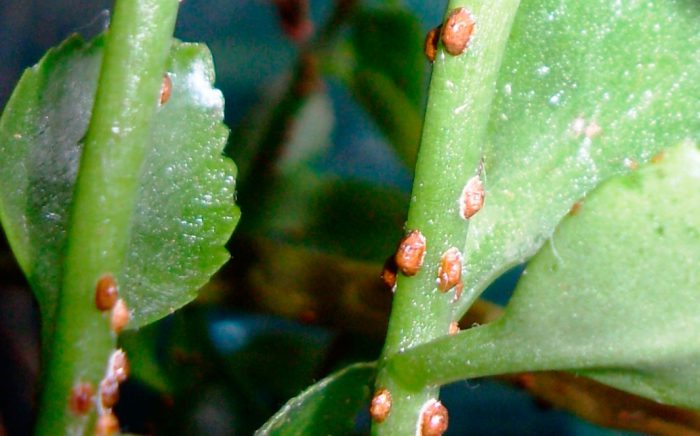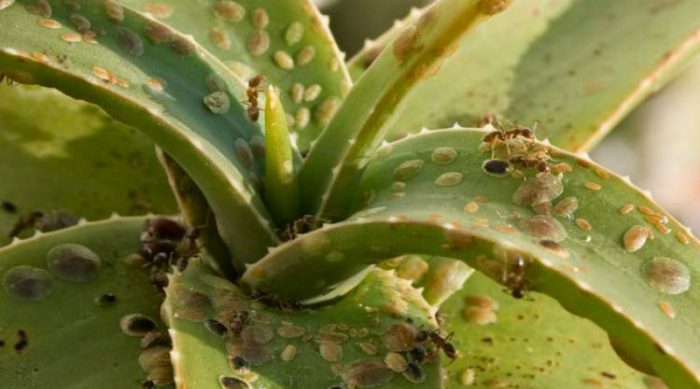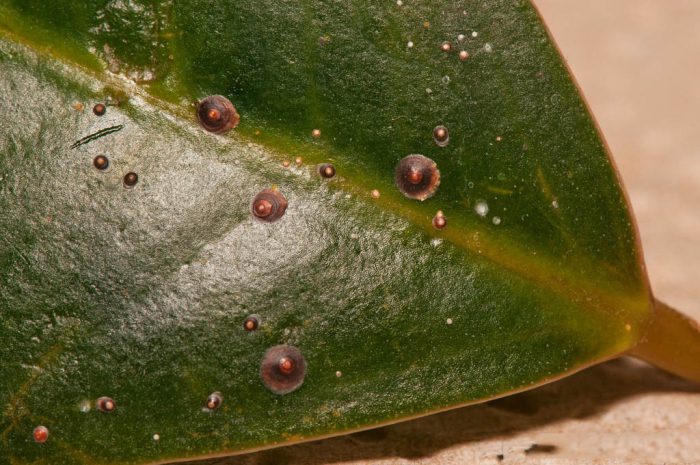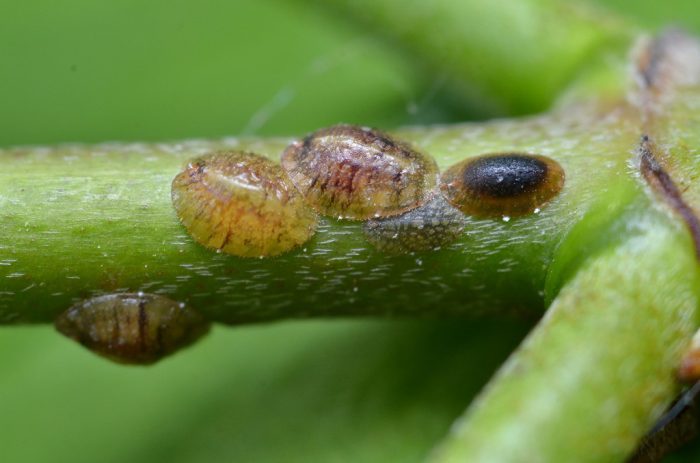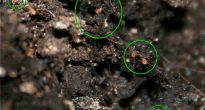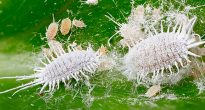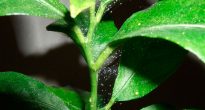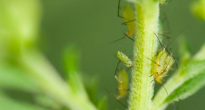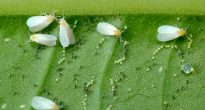The scabbard, as well as the false shield, is a harmful insect that can infect various plants. It poses a danger to a huge number of indoor plants. But especially laurel, citrus fruits, oleadra, palm trees, and also amaryllidaceae.
Scale insects (Diaspididae) are representatives of the family of homoptera of the coccid suborder. Their body is rounded. And it is noteworthy that females have coatings in the form of wax shields on top of their bodies.
The false shield is a member of a different family (Coccidae or Lecaniidae), but belongs to the same order of coccids. Their size is much larger than that of the scale insects, or rather, from 3 to 7 millimeters. These insects do not have a shield, and the eggs and larvae are protected by the dried body of the female.
In both the false scale insects and the scale insects, the difference between females and males is quite large. After the female becomes an adult, she stops moving, thus protecting the eggs attached to the surface of the plant. On the contrary, not very large males are quite mobile. At first, the larvae are also very mobile, but when they attach to the plant, they become immobile and they have a wax shield.
Content
Types of scale insects
In nature, there are a fairly large number of species of scale insects capable of harming any house plant. But they are very similar to each other, the difference is only in size and color.
- scale brown - most often this insect affects: ficuses, laurel, palm trees, camellias, citrus fruits, yucca, dracaena, boxwood, oleander, hibiscus and other plants;
- scale cactus - most of all prefers to settle on cacti;
- scabbard olive - settles on oleander, laurel, camellias, pomegranate, citrus, hibiscus, fat women;
- scaled palm - can seriously harm palm trees. Most often, these insects damage young leaves of fan palms that have not yet blossomed. They are also dangerous for bromeliads, orchids and other tropical plants grown at home.
What is the danger of scabbards
The larvae, as well as adults, feed on the sap of the plant. Adult females attach very tightly to the surface of the plant and stop moving, thus providing protection for larvae and eggs. In places where scale insects have settled, spots appear that have a brownish-red or yellow color. After some time, the leaves begin to turn yellow, the stems do not develop properly, and the infected plant also drops buds.It practically stops growing, and its branches gradually become bare, and soon the plant itself begins to wither, and eventually dies.
Getting rid of these harmful insects is a rather laborious process. The thing is that the shields they have protect them from chemicals.
Signs of infection (external)
It is quite easy to detect these harmful insects. Outwardly, they look like small convex tubercles or plaques that have a rounded shape. Their color may be different. So, they can be painted green, yellow or brown. Most often, they are attached along the veins on the leaves, both on the outside and on the inside.
It is worth knowing that scale insects produce a sticky secret. So, if the plant is infected very recently and the females are still almost impossible to see, then the leaves become quite sticky already at this stage.
Methods of dealing with false shields and shields
After even one scale insect is found on the plant, it must be immediately removed away from others. Also, be sure to check those home flowers that were next to the isolated plant.
After the scale insects become adults, they form a shield that protects them very well from insecticides. However, they can be removed manually from an infected flower. To do this, you need to prepare a soapy water solution and a cotton swab (small soft brush). Cotton wool is moistened in solution. Then you need to carefully wipe each leaf with it on both sides, and do not forget to process the stems.
After the plant is mechanically processed (cleaned of adult scale insects), it must be sprayed with an insecticide. Also, the surface where the plant stood and stands should be treated with a chemical. And do not forget about the surface of the window, since the larvae of this insect may be there too.
It is much easier to deal with false shields, since they are devoid of a dense shield. They can be completely destroyed with insecticides.
Those plants that have dense leaves of a sufficiently large size are easier to clean from the scale insects. It is enough to regularly inspect the plant and remove adult insects. Plants with small delicate leaves are almost impossible to get rid of these harmful insects. For example, scale insects can destroy asparagus or maidenhair.
Recommended insecticides in the fight against false shields and scabbards:
- Bankol - this agent of contact-intestinal action has a mild odor and destroys sucking and gnawing pests.
- Inta-vir is an intestinal contact agent with a broad spectrum of action.
- Actellik ― is distinguished by its effectiveness. It is worth considering that it has a very strong, persistent odor, therefore, it is not recommended to treat plants with it in closed rooms.
- Aktara is a broad-spectrum agent. They can both spray the plant and bring it into the ground. So, you can simply water the plant at the root with an insecticide dissolved in water, but only if it reaches a height of no more than 30 centimeters. Through the root system, Aktara spreads throughout the plant, making it toxic to pests.
- Mospilan - it has a systemic effect on the plant. It is able to absorb the drug in all parts. And after that, the insecticide is evenly distributed throughout the flower, and is contained even in those parts of it that have not been treated.
Plants must be processed according to the instructions attached to the preparation. Often, a few days after the first treatment, a second one may be required, since the pests that were at the time of treatment in the scales of the bulbs, as well as in the leaf axils, are likely to multiply again.
In addition to these insecticides, you can spray the plant with 96% alcohol. It is necessary to use a fine spray.It is worth considering that this substance is capable of burning the leaves, so first you need to spray a couple of leaves and see how the plant reacts. The leaves are moistened quite a bit, after which the substance should evaporate.
There are also a large number of folk recipes. So, for example, plants can be treated with garlic or onion water, pepper tincture, celandine juice solution, and so on. However, they can only be used in conjunction with a mechanical processing method. But if there are a lot of scale insects, then these funds will not cope with the task.

